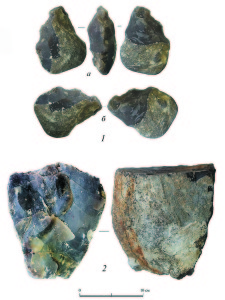Khizri A. Amirkhanov*
 Institute of Archaeology RAS, Moscow, Russia
Institute of Archaeology RAS, Moscow, Russia
*E-mail: amirkhanov@rambler.ru
Keywords: Dagestan, Mukhai II, the final stage of the Early Pleistocene (Eopleistocene), Oldowan, Acheulean, transitional industry.
The article discusses the materials in the timespan from approximately the end (?) of the Jaramillo palaeomagnetic episode (about 1 million years ago) to the end of the Early Pleistocene (about 0.8 million years ago). The study noted some signs uniting them that are significant in terms of the technological evolution of the Early Palaeolithic industry. These signs indicate that during the period in question the substitution of the traditions of the local Oldowan culture for the features characteristic of the Acheulean industry started. The discussed sites possess the following essential cultural and stadial characteristics that are common to them: the relevance of blanks in the form of large flakes (˃10 cm) for the lithic tools of the sites; the absence of worn-out shapes of bifaces in the presence of bifacial processing elements; items found among the lithic tools that can be identified as protobifaces. This cultural and chronological horizon can be defined as “the Early Pleistocene transitional large-flake industry”.
DOI: 10.31857/S086960630008862-7







